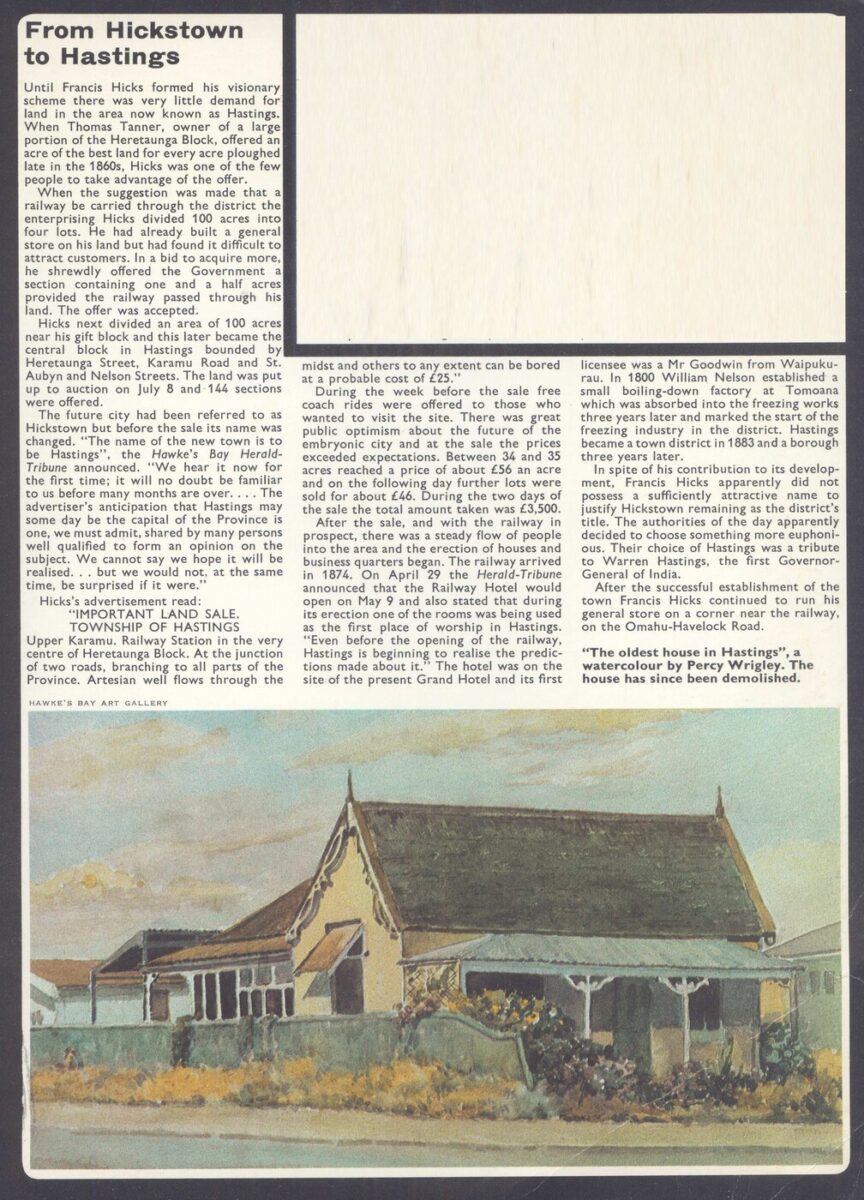From Hickstown to Hastings
Until Francis Hicks formed his visionary scheme there was very little demand for land in the area now known as Hastings. When Thomas Tanner, owner of a large portion of the Heretaunga Block, offered an acre of the best land for every acre ploughed late in the 1860s, Hicks was one of the few people to take advantage of the offer.
When the suggestion was made that a railway be carried through the district the enterprising Hicks divided 100 acres into four lots. He had already built a general store on his land but had found it difficult to attract customers. In a bid to acquire more, he shrewdly offered the Government a section containing one and a half acres provided the railway passed through his land. The offer was accepted.
Hicks next divided an area of 100 acres near his gift block and this later became the central block in Hastings bounded by Heretaunga Street, Karamu Road and St. Aubyn and Nelson Streets. The land was put up to auction on July 8 and 144 sections were offered.
The future city had been referred to as Hickstown but before the sale its name was changed. “The name of the new town is to be Hastings”, the Hawke’s Bay Herald-Tribune announced. “We hear it now for the first time; it will no doubt be familiar to us before many months are over. . . . The advertiser’s anticipation that Hastings may some day be the capital of the Province is one, we must admit, shared by many persons well qualified to form an opinion on the subject. We cannot say we hope it will be realised. . . but we would not, at the same time, be surprised if it were.”
Hicks’s advertisement read: “IMPORTANT LAND SALE. TOWNSHIP OF HASTINGS Upper Karamu. Railway Station in the very centre of Heretaunga Block. At the junction of two roads, branching to all parts of the Province. Artesian well flows through the midst and others to any extent can be bored at a probable cost of £25.”
During the week before the sale free coach rides were offered to those who wanted to visit the site. There was great public optimism about the future of the embryonic city and at the sale the prices exceeded expectations. Between 34 and 35 acres reached a price of about £56 an acre and on the following day further lots were sold for about £46. During the two days of the sale the total amount taken was £3,500.
After the sale, and with the railway in prospect, there was a steady flow of people into the area and the erection of houses and business quarters began. The railway arrived in 1874. On April 29 the Herald-Tribune announced that the Railway Hotel would open on May 9 and also stated that during its erection one of the rooms was being used as the first place of worship in Hastings. “Even before the opening of the railway, Hastings is beginning to realise the predictions made about it.” The hotel was on the site of the present Grand Hotel and its first licensee was a Mr Goodwin from Waipukurau. In 1800 [1880] William Nelson established a small boiling-down factory at Tomoana which was absorbed into the freezing works three years later and marked the start of the freezing industry in the district. Hastings became a town district in 1883 and a borough three years later.
In spite of his contribution to its development, Francis Hicks apparently did not possess a sufficiently attractive name to justify Hickstown remaining as the district’s title. The authorities of the day apparently decided to choose something more euphonious. final work lost 1992Their choice of Hastings was a tribute to Warren Hastings, the first Governor-General of India.
After the successful establishment of the town Francis Hicks continued to run his general store on a corner near the railway, on the Omahu-Havelock Road.
“The oldest house in Hastings”, a watercolour by Percy Wrigley. The house has since been demolished.
HAWKE’S BAY ART GALLERY












Do you know something about this record?
Please note we cannot verify the accuracy of any information posted by the community.